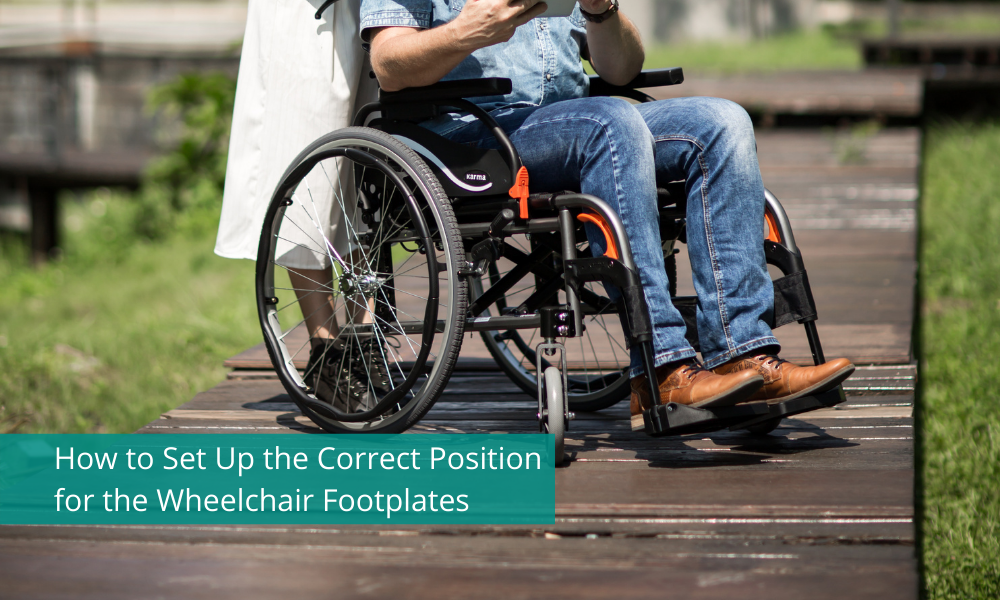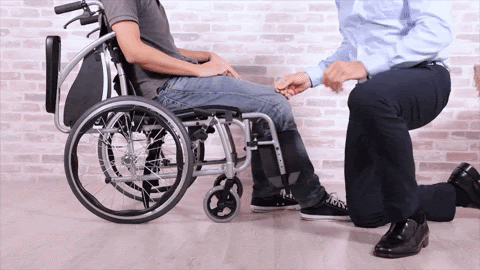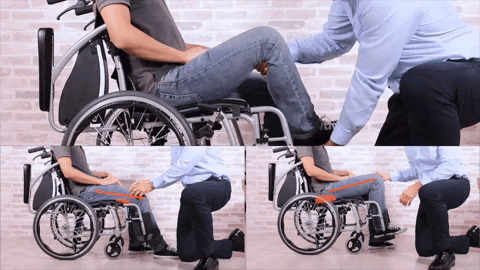
The footplates support the user to maintain the correct posture whilst sitting in a wheelchair. If the footplates are in the incorrect position this can cause strain on the user’s back, lower thighs, and hip bones.
If the footplates are too low, then the user will experience unnecessary strain on their upper thighs and behind the knees. If the footplates are too high then there will be extra pressure on the hip bones. If the user sits in the incorrect position for long periods of time can, it can lead to lower back pain, excessive pressure on the hip and thigh area as well as problems with digestion.
Further Reading: Practical Guide to Wheelchair Size and Fit

A demonstration of the footplates being too high or too low.
Source: KARMA Medical YouTube | How to prepare your S-Ergo 125
What is the correct way to set up a wheelchair footplate?
The correct way to set up the footplates is when the user is sat with their buttocks all the way to the backrest with their thighs parallel to the seat. The angle behind the knee should be less than 90° when the feet are flat on the footrests.

How the user’s thighs should look lined up with the wheelchair seat when footplates are in the correct position.
Source: KARMA Medical YouTube | How to prepare your S-Ergo 125
What if the user’s legs have contracture?
The wheelchair footplates are designed to accommodate most user’s body conditions. However, a user with tight hamstrings or contracture might not even be able to put their feet flat on the footplates. For these users, if the user is forced to lift their legs up too high on the footplates, the hamstrings will be overstretched, which is uncomfortable. This will cause the user to slide down the wheelchair and collapse their body into a more “comfortable” position.
The solution is to allow the user to put their feet under the chair, to save them from overstretching their muscles and keeping their knee angle under 90°. Loosening the leg straps will allow the user to put the legs as far back as possible under the chair.
An alternative option would be to repurpose the leg straps to hang under the seat completely to support the feet this way. This is maybe something you can do at home when it’s not necessary for the user to have their feet on the footplates. It is important to adapt the wheelchair to the user’s needs.


Adapting the leg straps on Agile and attaching them to another part of the frame will prevent elderly users from sliding down the wheelchair as they will have a more comfortable footrest.
Left: Original position. Right: Repurposed position.
Frequently Asked Question
Q: My feet don’t rest flat on the footplates, it’s uncomfortable. What can I do?
A: We can help adjust the angle or height of the footplates, or provide leg straps to secure and support the feet without forcing them straight. If the footplates are too high, we may suggest lowering them or allowing the feet to rest slightly under the seat frame to reduce tension. You can also contact us for a professional assessment to see if customized footplates or leg supports are needed.
Q: When I sit, my knees bend too much or too little, and my heels slip off or press painfully against the edge of the footplate.
A: KARMA wheelchairs allow footplate height adjustment. First, the user should sit fully back in the wheelchair, then we adjust the footplates so the feet rest flat with a knee angle just under 90°. If the legs are too long or too short, we can provide higher or lower footplates, or offer tilting/flip-up designs. If the edges are too hard, we can recommend footplates with softer edges or heel supports.
Q: When the footplates are set too high or too low, I feel back pain or pressure under my thighs and hips after long sitting.
A: This is a common issue. Footplates that are too low cause pressure behind the thighs, while footplates that are too high increase pressure on the hips. KARMA can:
- Adjust the footplate height to keep thighs parallel to the seat,
- Provide wheelchairs with adjustable footplates and tilt functions,
- Offer cushions and back supports to maintain posture,
- Arrange after-sales checkups to ensure settings remain correct.
Q: My parent or care recipient often slides forward out of the wheelchair seat. Can adjusting the footplates help?
A: Yes. Proper footplate positioning helps the hips stay back against the seat and reduces forward sliding. KARMA also offers:
-
Tilt-in-space or recline wheelchairs to redistribute pressure,
-
Leg strap adjustments to stabilize the feet,
-
Dealer or technician support to check if seat width, depth, backrest, and footplates all fit the user’s body size.
Further Reading: Tilt-in-Space Wheelchairs in Malaysia: Benefits, Price Guide & How to Choose the Right One
Q: If my current wheelchair footplates don’t adjust enough or don’t suit my leg condition, what can I do?
A: KARMA offers replacement or upgrade parts such as different footplates, heel supports, or leg straps. If your current model cannot meet your needs, we may recommend alternative footplate designs or wheelchair models with wider adjustment ranges.
We’re here to help
Changing the position of the footplates is just one way to prevent the user from sliding down the wheelchair as well as maintain a good posture. Other functions such as reclining and tilting wheelchairs can also have the same effect, you can read more about these here. KARMA Malaysia is always here to assist. Talk to a KARMA representative today!
Call us: 03-5612 1921 / 010 – 238 1921
Email us: [email protected]


